Public Communication on Sciences and Technologies
André Giordan
Conference presented in CERN, 2001
The 20th century will go down in history as the century of horror and atrocities. And yet, that century was fertile in new ideas, namely in the fields of Science and Technology. In centuries past, individuals would see one scientific discovery during their lifetime, if they were lucky. In the 20th century, men took to the skies, explored space and walked on the moon. They appropriated electricity for a variety of uses: lighting, heating, cooking (from the electric ring to the micro-wave oven), radio, and a number of automated processes. They invented audiovisual techniques, computers, telematics, robotics and other forms of automation, and Information and Communication Technologies.
In the world of science, several approaches proved incredibly fruitful. Research scientists dissected matter and modeled the atom, and then they broke it up into elementary particles (quark, leptons, etc.). In the Life Sciences, the cell was taken to pieces and many of its mechanisms understood. Genes and DNA were analyzed. Last year, the human genome was almost entirely decoded. Every day, new horizons open in medicine and other branches of the life science.
1. Scientific knowledge and image
Of course, everything went too fast, much too fast. And all this knowledge remains very inadequately disseminated. Over the past 20 years, all surveys show the extent to which the public is removed from scientific knowledge. Recently, we tried to assess a body of students’ knowledge about a subject that’s in the news: DNA. On DNA, it was clear that, above all, they know the name, or the sound of that name! Most of the time, DNA is translated as desamine nutro amine", desory nitro acide, "detroxy nuclear anime', " desoxy ribomécanism nuclide acid"...
They are vaguely familiar with genetic processes. But this knowledge is never really operational. The diagrams they produce show that two-thirds of them have committed the double helix to memory, but all the rest is anecdotal, from the letters used ("d", "s", "b".) to represent specific structures (schema 1).

Conceptions of DNA’s structures
They do not generally master the relationship with the genes, chromosomes, or even protein synthesis. Some time, a gene is a nucleotid, some time a gene is represented by one level of the helix, some time again the gene is inside the scale (schema 2).
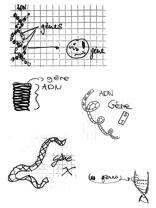
Relations between genes and chromosomes

And these youngsters have completed secondary level schooling. What about the general public?
And this is not our most serious problem. The image of the sciences has deteriorated, while the irrational spreads through our society.
Science is no longer automatically associated with the idea of progress. On the contrary, it generates fear. A survey recently conducted in Europe shows that while Europeans are prepared to accept therapeutic innovations, their doubts with regard to other applications should not be taken lightly.
Worse, numerous scientific practices, beginning with genetic manipulations, are vigorously rejected by certain categories of the population. And the most virulent detractors of GMOs do not come from the most conservative groups in our society, but from progressive circles and environmentalists.
Scientific progress has been accused of triggering unemployment. It has been accused of being at the origin of dramatic problems that threaten our planet (climate changes, holes in the ozone layer, etc.) and our health (mad cow disease, the contaminated blood scandal in France, etc).
Moreover, the scientist is no longer the “father” of the people or the “savior of mankind”. Particle physicists, molecular biologists and geneticists all appear on the television as “cold” researchers, dehumanized, avid for power, in the service of multinationals.
2. The limits of Public Communication
And yet there is no lack of initiatives in terms of Public Communication on Sciences and Technologies know-how. Many new players are getting involved, notably among scientists and more recently, engineers. Original experiments have been tried out, and ambitious projects carried through. This “wealth of information” seems to be ill-exploited and gets lost in a host of one-off and extremely varied initiatives.
 The problem does not lie in the sterile opposition between scientists and journalists. Admittedly, scientists continue to restrict themselves to risk-free, conventional operations such as conferences, open days and science weeks, i.e. actions that only reach a limited number of people. Admittedly, scientists continue to present their scientific work with their own language through their own concepts.
The problem does not lie in the sterile opposition between scientists and journalists. Admittedly, scientists continue to restrict themselves to risk-free, conventional operations such as conferences, open days and science weeks, i.e. actions that only reach a limited number of people. Admittedly, scientists continue to present their scientific work with their own language through their own concepts.
And admittedly, journalists too often go in for spectacular-type events, which they cover using frivolous terms and catchy titles. However, close examination leads one to think that this opposition is largely symbolic.
The main problem is the immaturity of Public Communication that should be called into question. Many efforts are never analyzed and the immense majority remains unknown. The lack of sharing experiences leads to a duplication of efforts, effects that are scattered, and original, interesting approaches going unrecognized. And above all, the same mistakes are repeated. Hence the importance of symposiums such as this one or our International Days every year in Chamonix (1).
3. Evaluations and researches on Public Communication
But first of all, it is important to develop assessment surveys. Numerous scientific television programs or newspaper articles remain incomprehensible. They do not take questions from the public  sufficiently into account, which frequently leads to boredom, disinterest or even the exclusion of the viewer or the reader.
sufficiently into account, which frequently leads to boredom, disinterest or even the exclusion of the viewer or the reader.
Many exhibitions are little more than a prestigious operation where the priority is not sharing or imparting knowledge. Many of them have a disastrous value-for-money ratio. Certain exhibition rooms group everything that should not be done. To such an extent, it should better to close these spaces and keep them to train future museologists.

Research in scientific communication has become a “necessity”. A close look should be taken at its mechanisms and at its broadcasting logic. And more important, the processes used to appropriate scientific ideas should be understood.
Today, all the authors of scientific communication agree that to make progress it is essential to get to know the public better. Our Laboratory has produced a lot of researches on the conceptions of the public.

Learning is a complex function, and can't be reduced to a single model. Owing to the number of its aspects, it even presents multiple paradoxical components. For example, the individual understands, learns the environment through his conceptions. They are the only tools he masters; it's through them that he decodes reality and the information he receives.
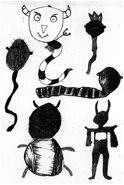
Microbe’s conceptions
At the same time, they are his intellectuals "prisons" which enclose him in a way of understanding the world: a linear causality, a classic logic, for example. To learn in a period of social mutation, he will have to go against that, though he can only do so much.

Conception's components in conceptual learning
In the use of simple notions of classic physics, with the same words (force, energy, work, acceleration, power...) the expert and the learner don't operate on the same networks of meaning. Their experiences don't have the same meaning. The force which is applied to the center of gravity is an invention of the spirit which suits the scientist or the engineer. It's a good explanatory idea, but one has to master the conditions of application for it "to work". The object must be assumed to be coherent; if it's deliquescent the concept "center of gravity" becomes useless.
|
This will become a key tool in conceiving and successfully carrying through initiatives. As we all know, the difficulty is that the “general public” does not exist. The problem of one or many different audiences remains one of the most relevant and the most awkward challenges. We must understand this complex mixture of attitudes, approaches, ideas and centres of interest and take it into account, and not try to reduce it to a mean average.
If we do not reinforce research, and in particular research and development on production show, museums or media. Without more careful thought, without systematically publicizing results, Scientific Communication will necessarily lead to a sort of D-I-Y, where we are constantly reinventing the wheel.
When we observe the scientific mediation, we can see three great traditions. The first describes learning as a simple recording mechanism. Carried out by a "virgin" and always available brain, the acquisition of knowledge is the direct result of transmission. That empirical proposal supposes a merely linear, frontal relation between a broadcaster (journalist, museologist), the holder of knowledge, and a receiver (young or general public), who memorizes successive messages.
The second tradition rests on training elevated to the rank of principle. We conceive situations accompanied with a questioning which can find immediate answers. Learning is favored by "rewards" (positive reinforcement) or "punishments" (negative reinforcement). Through such conditioning, the individual eventually adopts the right behavior, the one which avoids the negative reinforcement.
The third tradition is that of so-called pedagogy "of construction". It starts from the spontaneous needs and "natural interests" of individuals. It advocates their free expression, their creativity and their knowledge of how to be. The construction of knowledge is operated largely by action and the expression of the pupils' representations. The so-called "active" methods, a certain number of research centers are built on that educational model.
Unfortunately, each tradition has a lot of limits. To mediatize derives more from a complex alchemy. Our Laboratory have produce the allosteric model to categorize and to establish relationships, and hence to infer and to foresee the system of indispensable parameters to mediatize sciences and technologies.
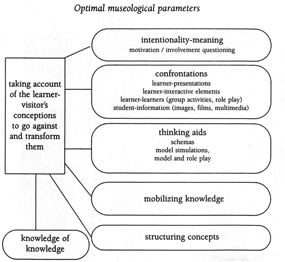
Allosteric environment to mediatize
All these are so many limiting factors; learning is impossible when one is missing from the roll call. Likewise as they are all interacting, there's a subtle cocktail to be prepared by education or mediation. The arguments which convince are quite diverse according to the individuals.
A regulation between those different parameters by the learner has not yet been envisaged. We forget what is useless, but also what is too intense: a trauma which shatters our balance, the knowledge of an incurable disease, creates too strong a dissonance which dispels all acquisition. To learn, we need to have our certainties disturbed, but if they are too disturbed we become paralyzed.
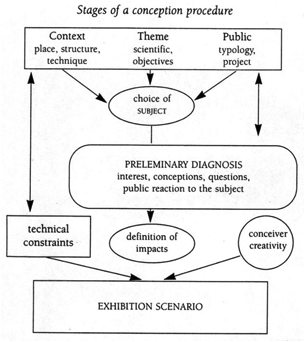
Research-Development on Public Communication production
4. Public Communication Project
In addition, we should not consider the general public as an “overall” target and get entrapped into thinking only of supply. However, to think solely in terms of demand, and question the diversity of motivations, and means of access to information, is equally sterile.
Taking the public as a starting point does not means staying at that level. Public Communication on Sciences and Technologies should put forward original projects, invent new approaches, but it should first call its activities into question.
Does it want simply to make the public enter the scientists’ world or is it seeking to help the public understand “its world”? The way one poses a question can reveal a huge difference in point of view. To say that we are going to “talk about” the composition of air is not the same thing as to say that we are going to question the quality of the air in our own town.
Are we aiming to bring the public into a world other than its own, to introduce it to an approach, or do we want to help individuals to see where they stand in their life environment? Do we want to promote their autonomy? Do we hope, for example, that the individual will intervene in societal choices? This is the heart of the debate on Public Communication.
At the risk of shocking some of you, the Scientific Communication project is no longer to “transmit” sciences. Or at least to transmit them for themselves.
 Through scientific activities and actions – to be proposed – priority should go to enabling every individual to appropriate a scientific and technological culture. By that I mean a way of approaching, questioning and positioning…
Through scientific activities and actions – to be proposed – priority should go to enabling every individual to appropriate a scientific and technological culture. By that I mean a way of approaching, questioning and positioning…
It’s another way of looking at the world around us, at phenomena and, above all, at the problems that individuals encounter.
To my mind, Scientific Communication has a duty to trigger people’s interest in science, to encourage them to find time for science, to question and to have a critical, open mind to knowledge. The main priority is to promote individual to be curious about things that are neither obvious nor familiar, to want to find out for themselves, and to be confident enough to do so.
At the same time, Public Communication must, above all, suggest other approaches, like pragmatic, systemic analyze, modelization (see above).

Science education project
An other proposal for Public Communication is also to introduce some benchmarks: a sort of “basic” (some basic knowledge called "structuring concepts)), in other words some knots" to organize the many pieces of isolated information that come from the media together.
But perhaps, the main priority of the Public Communication on Sciences and Technologies must be to develop "knowledge about knowledge", a reflection upon". So that every individual may see the stakes, the links between science and society, science and values.
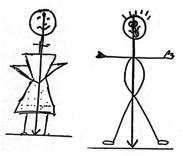
Force’s conceptions
But mediation takes on all their meaning at that instant. For another paradox, if the individual has to learn on his own, and no-one can do it for him, the learner has little chance of discovering on his own the set of elements which can modify his questions, his concepts or his relation with the knowledge. The meaning we attribute to knowledge can't be directly transmitted. But the mediator can facilitate that production of meaning by filtering the multiple items of information, by amplifying or reducing the input of external stimuli. He can facilitate comparison, relationships (time, space, cause) or encourage organization.
|
This point of view is not a theoretical aspect for our team. Our Laboratory produce different products on Public Communication on Sciences and Technologies: books, letters, shows, museums, CD-Rom or Website.
In one of our book, called The body, the first marvelous in the world (Le corps, la première Merveille du Monde, in French, translated in Spain, Japanese and Korean languages), the idea developed is not to "give" some knowledge on the body. First we try to promote a questioning about our body. We do not explain a function, for example, the digestion. We begin by a question: "Do you know that salad, beef, potatoes that you eat become you?" and "How salad, beef, potatoes become you?»
Other question are more essential: "Do you know the probability you had to born?", "All the time, you are changing your cells, and the matter of the cells is changing…Who are you ?", "Your memory is reorganized every nights… Who are you?,...
The same approach has been promote on museum or exhibitions we have produced. For example in the Luxembourg Science Museum, we have introduced three sorts of spaces. The first one is not a space to explain, but a space to promote a questioning.
It starts from the main questions of the public: "What are you?" or "Where do you come from?"
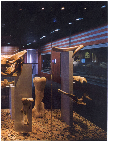
"What are you?" Space in Luxembourg Science Museum
(Agencies Repérage et A. Giordan)
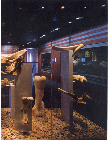
"Where do you come from?" Space in Luxembourg Science Museum
(Agencies Repérage et A. Giordan)
1. Annual CECSI’s days ("Journées de Chamonix") organized by LDES and LIREST, http://www.ens-cachan.fr/recherche/lirest/jies.html